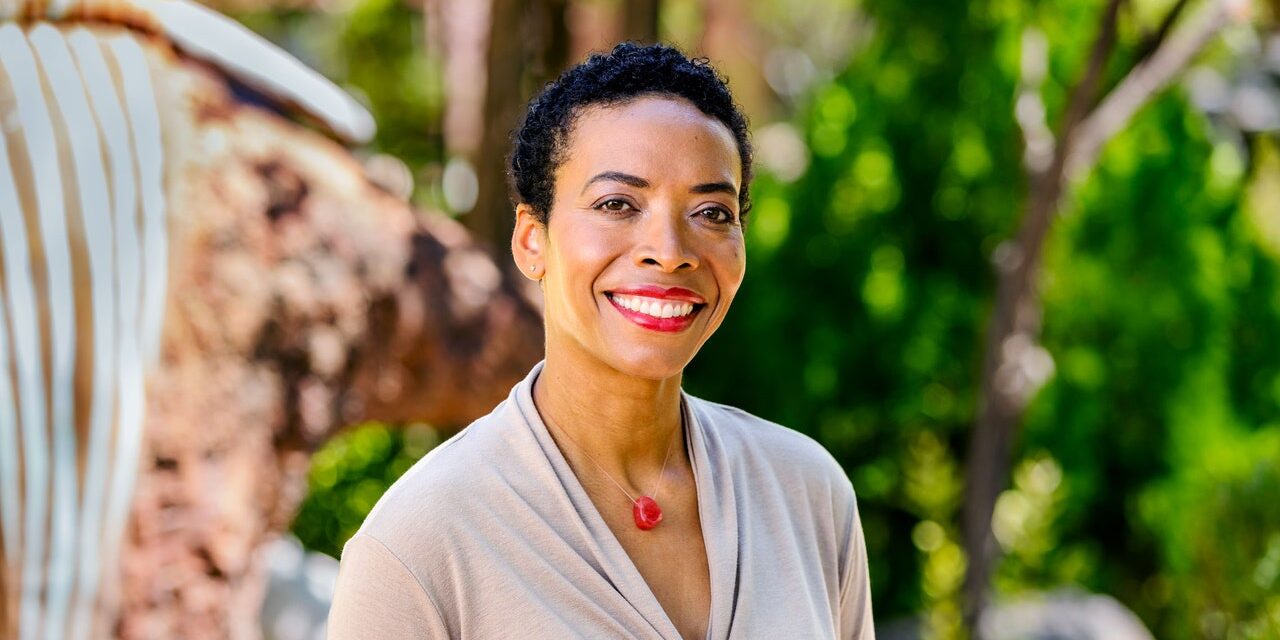
When Aomawa Shields temporarily left astronomy in the 1990s for a life in the theater, no one knew whether planets existed beyond our solar system. By the time she returned to academia 11 years later, hundreds of exoplanets had been discovered. Today, telescopes and detection methods have advanced so much that the discoveries number close to 6,000.
Shields, now an astrobiologist at UC Irvine, studies these distant worlds using computer models to evaluate their climates and assess whether they might be friendly to alien life. During this second stint in academia, she completed her PhD at age 39 and afterward gave birth to her daughter. She has been named a 2015 TED Fellow, she’s the recipient of multiple grants and awards from NASA and the National Science Foundation, and she’s the founder and director of Rising Stargirls, a program encouraging girls of all colors to learn about the universe through theater, writing, and visual arts.
In her new book out today, Life on Other Planets, she discusses her scientific work, as well as her own experiences as one of the few Black women in physics and astronomy and as a classically trained actor who completed her master of fine arts degree at UCLA.
Shields has a spiritual side that many scientists shun. Throughout her book, she eloquently shares her thoughts about why humanity searches for extraterrestrial life. “I don’t believe I will truly accept or understand how big the universe is until I know that other life-forms share it. With that knowledge, the sky is no longer a snow globe, but a window. The universe, the galaxy I peer out into at night, peers, back at me,” she writes.
This conversation has been edited for length and clarity.
WIRED: Why do you think it’s important to search for life in the universe?
Aomawa Shields: Since looking up at the sky, when I first did it as a child, there was always the question in my head: “What is out there?” When I came back to astronomy, I wanted to get a PhD in astrobiology and determine what kind of life is out there and what planets would be the best planets to look for that life.
The way I do that now is using computer models. Once planets are discovered, I get to find out how habitable they really are—because there’s not a whole lot we know about these planets that are Earth-sized that we find. With computer modeling, we can put in information we have about a planet’s environment, and we can fill in the gaps. OK, we don’t know what its atmosphere is like, but what kind of atmosphere would allow it to support liquid water on its surface? What kind of surfaces—when interacting with the host star’s light—would generate a climate that’s warm enough for liquid water but not too warm to evaporate it out into space?
Then we identify those planets that seem to be the most habitable across the widest range of these atmospheres and surfaces, and maybe even orbital configurations. Those are the planets that we’d like next-generation telescopes to follow up on, to look for signs of life.
If we were looking at an exoplanet like our Earth, could we tell that it might be habitable—or even inhabited?
That’s tricky, because it requires us to come up with a recipe of signs we could take out from the atmosphere. We call them biosignatures, signs of biologically generated global impacts on a planet’s atmosphere or surface that we can observe remotely that would tell us unequivocally that life is present.
It can’t just be oxygen. Though we know a lot of life on Earth needs oxygen, not every type of life needs oxygen, and oxygen can be created by volcanoes. CO2 goes into the atmosphere and it’s split apart by light. So if there’s a lot of oxygen in the atmosphere, and if we use that as our only criterion for life being present, that could be a false positive.
So we’re thinking about a suite of atmospheric gases, and maybe even surfaces. If we could look for a glint of liquid on the surface—the fancy word for that is “specular reflection”—that would tell us there’s a liquid there. But that liquid might not be water. Saturn’s moon Titan is an example. We did detect a glint from Cassini’s mission, but that glint was coming off of liquid ethane and methane lakes.
The climate and the weather on another planet can be impacted by so many things. We use models that were historically used to predict climate and weather on the Earth, predicting the effect of climate change through the 2100s. We’re using them to predict the climate on these exoplanets. We change the host star, we change the atmosphere, we change the surface, and we see what the climates could be, based on the information we have about the planet.
We don’t want too thick of an atmosphere on an exoplanet because that could create a Venus, heating up the planet. But if the atmosphere is too thin to support liquid water on the surface, we might get a Mars—and liquid water could not flow on Mars’ surface today, because of its thin atmosphere.
An Earth atmosphere might work. But that depends on how far away the planet is from the star and what kind of star it is, because stars emit light at different wavelengths, and the majority of stars in the galaxy are not like the sun. The majority of stars are cool, red, smaller stars. Infrared light from those stars can interact with atmospheric gases and water ice in a very unique way compared to visible light from the sun. And that interaction can affect the climate.
When do you think you and fellow astrobiologists will finally be able to say: “We think this particular planet has an X percent chance of being habitable?”
I feel confident that we will be able to. If our colleagues find a planet—especially a close planet with the Transiting Exoplanet Survey Satellite, which is Kepler’s successor, this all-sky survey that’s looking for planets that pass in front of their host stars and block out a little of their light of their star—that allows us to discover the planet and calculate its size. If that planet is small enough to be Earth-sized, it has a greater chance of being rocky, and therefore something that something could stand on and an ocean could exist on top of.
The closer that planet is, the easier they are to be followed up on with missions like James Webb and hopefully, proposed next-generation missions called LUVOIR and HabEx. If one of these missions go up, then we can do that and have a much more refined percentage estimate on these habitability factors for these planets.
Suppose you or other astronomers eventually find what looks like not just a habitable alien world but an inhabited one? What will it feel like for humanity to make such a discovery?
It would be incredible. It would be overwhelming. Certainly if I had a hand in it, I would feel even more personally elated.
I work on exoplanets, so I don’t spend much time thinking about our own solar system, where we might end up discovering life, but they are there: Saturn’s moon Enceladus, Jupiter’s moon Europa. Definitely we can see a lot more of those moons than we can of exoplanets. It may be an exoplanet; it may be in our own backyard. We can definitively imagine going to Europa and drilling down through that ice and pulling up some microbes there. At that point, we would know that there are multiple origins of life. That knowledge, regardless of what the next step is, changes so much about our history.
How did you get interested in both acting and astronomy?
At first I thought they’re way too separate or different to be combined. Astronomy was my first love, looking up at the night sky and wondering what was out there. Then when I was in high school, I ended up getting dragged into an audition for the play Steel Magnolias. I ended up being cast. Once I started doing more acting, I realized I have these two things I enjoy.
Do they feel like different sides of yourself, or are they connected in some way?
In some ways they do feel like different sides of myself. I love embodying different characters, and I love even expressing feelings and emotions. And I couldn’t really find a way to do that at first in the sciences. Now I understand they’re actually quite linked. How I feel about what I study is essential to me being about to study it with full participation. I think I understood that once I had to select a dissertation topic in graduate school: It had to be something that I felt connected to. And that began my discovery, that the feelings, the emotions that are manifested in the stories the characters play out, those are directly related to what those characters are doing with their lives, and directly related to my own emotions, directly related to how I carried out that research and that scientific discovery process.
What was your motivation for writing this memoir, Life on Other Planets?
For so long I thought, “It’s so strange to have these two loves, astronomy and acting.” And when I would share those loves with other people, I got responses like, “Whoa, how did that happen?” and “That seems weird!” And I internalized that. I spent a long time trying to resolve what I felt was a conflict: I should choose this. I should choose that. So I wrote this book because, once I realized that once I stopped trying to figure it out and choose, the possibilities presented themselves to combine these two things. They weren’t mutually exclusive, and in fact they could inform and influence each other. It made me a better professional, a better scientist, a better artist. That’s when magical things began to happen.
I discovered over the past several years that I’m not as rare as I once thought I was. There are many people out there who have a science and arts interest and aren’t quite sure how to combine them. I wrote this for people who have more than one interest, maybe more than two, and they’re not sure what to do about that. I wrote it for people who think that it’s too late to have that life or career they wanted to have because of personal, financial, logistical challenges. As an older returning student, I had thought, “It’s too late to get a PhD. I’ll be 40 when I graduate.” Then I realized that—hopefully—I’ll be 40 either way, so if I wanted a PhD I might as well get it.
And I wrote it for people of color who inhabit primarily white spaces, so that they know that they are not alone and there are ways to navigate and thrive within these spaces, and to be their own role models.
Even in 2023, astronomy in the US remains overwhelmingly white, and women of color are still rare in the field. Can you talk a little about how you reflect in your book on your experience as a Black woman in astronomy?
It certainly has been easy for me to feel different, because in many ways, I am. And certainly having those three different issues—being a Black woman in a predominantly white space, being an older returning student, being a classically trained actor—I had all of the ingredients for impostor syndrome. But I also have found allies across color lines. It’s that looking for the communities, both Black communities and other communities of color, and being open to finding allies in the majority communities, that has allowed me to see myself, rather than as someone at the effect of a systemic problem, to see myself as an agent of change. By simply existing in the space I exist in, I am effecting change.
It’s also empowered me to take care of myself in ways that I may not have otherwise. Women of color in these predominantly white spaces, we get asked to do a lot, we get invited to serve on committees and to be the diversity whatever, and it has pulled at my sense of responsibility: I have to be that person for the next generation. But what I understand is, simply by taking care of myself, physically, mentally, emotionally—that is change. That is allowing myself to do what I need to do to be an example, to be in this field long enough so that I can effect even more change. If I’m giving so much of myself that I don’t have anything left, that can harm the whole environment and the whole landscape with which I hope to positively change. It’s a balancing act.
In your experience, have things changed much for Black women—or people of color in general—over the course of your career?
The statistics are different for different communities of color. In physics and astronomy, we see a much larger improvement for Latinx women compared to African American women. Unfortunately, for African American women in physics and astronomy, the numbers are pretty static dating back to the early 1990s.
And that’s for bachelor degrees. As you get to PhDs, the numbers are still rather low. We have a website that was started by Jami Valentine and other physicists and astronomers, and I’m one of 26 Black women, ever, who got a PhD in an astro-related discipline. So there is still a long way to go.
But what I am seeing in these last several years, especially since the Black Lives Matter movement surfaced in a new way, is that there’s more support than there once was. So we have Black in Astro, communities on Facebook, organizations and programs in the American Astronomical Society, the American Institute of Physics. We have mandates that are being supported by our national organizations, our professional organizations, to devote resources to support participation of historically marginalized communities in astronomy. And more support networks. There are programs that didn’t exist when I was a PhD student that first time around, in 1997, and they do now. So that leads me to feel hopeful about the increasing participation of women of color, and Black women in particular, in this field.





